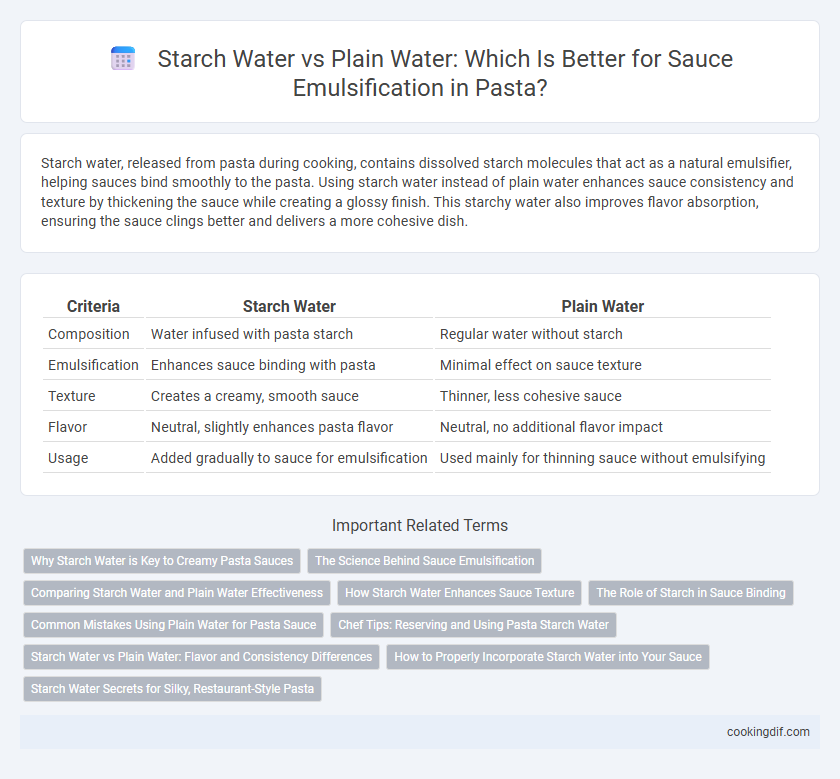Starch water, released from pasta during cooking, contains dissolved starch molecules that act as a natural emulsifier, helping sauces bind smoothly to the pasta. Using starch water instead of plain water enhances sauce consistency and texture by thickening the sauce while creating a glossy finish. This starchy water also improves flavor absorption, ensuring the sauce clings better and delivers a more cohesive dish.
Table of Comparison
| Criteria | Starch Water | Plain Water |
|---|---|---|
| Composition | Water infused with pasta starch | Regular water without starch |
| Emulsification | Enhances sauce binding with pasta | Minimal effect on sauce texture |
| Texture | Creates a creamy, smooth sauce | Thinner, less cohesive sauce |
| Flavor | Neutral, slightly enhances pasta flavor | Neutral, no additional flavor impact |
| Usage | Added gradually to sauce for emulsification | Used mainly for thinning sauce without emulsifying |
Why Starch Water is Key to Creamy Pasta Sauces
Starch water, rich in gelatinized starch molecules released from pasta during cooking, acts as a natural emulsifier that binds oil and water in sauces, creating a smooth, creamy texture. Unlike plain water, starch water enhances sauce adhesion to pasta, intensifying flavor and preventing separation. This key ingredient transforms simple sauces into rich, velvety coatings, essential for authentic Italian pasta dishes.
The Science Behind Sauce Emulsification
Starch water, released during pasta cooking, contains amylose and amylopectin molecules that act as natural emulsifiers, allowing oil and water-based sauce components to blend smoothly and cling to pasta. Unlike plain water, starch water increases the sauce's viscosity and helps form a stable emulsion by trapping fat droplets within a gelatinized starch matrix. This scientific interaction enhances the sauce's texture, mouthfeel, and flavor integration, creating a cohesive and silky coating on each pasta strand.
Comparing Starch Water and Plain Water Effectiveness
Starch water released from pasta during cooking contains amylose and amylopectin molecules that bind with fat, enhancing sauce emulsification and creating a smooth, glossy texture. Plain water lacks these starches, limiting its ability to thicken or stabilize sauces, often resulting in a thinner consistency. Using starch water improves sauce adhesion to pasta by effectively combining oil and water components.
How Starch Water Enhances Sauce Texture
Starch water, rich in gelatinized amylose and amylopectin released from cooked pasta, acts as a natural emulsifier that binds oil and water in sauces, creating a smoother and silkier texture. The starch molecules increase the sauce's viscosity, allowing it to cling better to pasta strands and enhancing mouthfeel. Unlike plain water, starch water prevents sauce separation and contributes to a creamy consistency without added fats or thickeners.
The Role of Starch in Sauce Binding
Starch water released from pasta contains amylose and amylopectin molecules that act as natural emulsifiers, effectively binding oil and water in sauces for a creamy texture. The fine starch particles suspended in the water increase viscosity, helping sauces adhere better to the pasta surface and prevent separation. Using starch water instead of plain water enhances sauce emulsification, ensuring a balanced and smooth consistency in dishes like carbonara and cacio e pepe.
Common Mistakes Using Plain Water for Pasta Sauce
Using plain water for pasta sauce emulsification often leads to sauces that lack proper consistency and gloss because it does not contain the vital starch needed to bind the sauce and pasta. Starch water, rich in amylose and amylopectin, creates a natural thickening effect, enhancing sauce adhesion and smoothness. A common mistake is discarding the starchy pasta water, which undermines the sauce's ability to emulsify effectively and results in a watery, separated texture.
Chef Tips: Reserving and Using Pasta Starch Water
Reserving pasta starch water is essential for perfect sauce emulsification, as it contains amylose and amylopectin released during cooking, which act as natural thickeners and binders. Using this starchy water instead of plain water helps create a silky, cohesive sauce that clings to pasta, enhancing texture and flavor balance. Chefs recommend adding small amounts gradually while tossing the pasta and sauce for optimal consistency and mouthfeel.
Starch Water vs Plain Water: Flavor and Consistency Differences
Starch water enhances sauce emulsification by binding fat and liquid, resulting in a creamier, richer texture compared to plain water. The starchy residue released from pasta contains amylose and amylopectin, which improve sauce consistency and help flavors adhere more effectively. Using starch water instead of plain water intensifies the sauce's mouthfeel and depth of flavor, creating a more harmonious pasta dish.
How to Properly Incorporate Starch Water into Your Sauce
To properly incorporate starch water into your sauce, reserve about one cup of pasta cooking water before draining the pasta, as it contains gelatinized starch that enhances sauce emulsification. Gradually add the starch water to the sauce while stirring vigorously to achieve a smooth, glossy texture that binds the sauce to the pasta. Avoid adding plain water, which lacks starch and can dilute the sauce rather than improving its consistency and creaminess.
Starch Water Secrets for Silky, Restaurant-Style Pasta
Starch water, rich in gelatinized starches released during pasta cooking, acts as a natural emulsifier that binds sauce and pasta for a silky, restaurant-quality finish. Its unique molecular structure enhances sauce viscosity, creating a creamy texture without adding fat or cream. Using starch water instead of plain water elevates emulsification by smoothly integrating oil or butter, delivering a perfectly glossy and clingy sauce.
Starch water vs plain water for sauce emulsification Infographic

 cookingdif.com
cookingdif.com